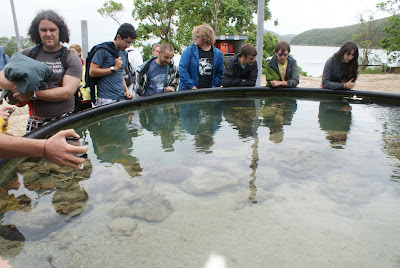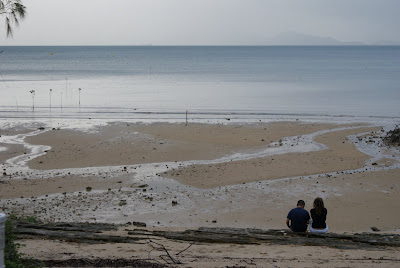

One of the things I love most about being a marine biology student is the field trips we get to go on. Over the past month I have stayed on a private research island learning about corals for three days, participated in an active reptile search in a nature preserve comprised of saltwater marshes and bushland, and have helped drag nets through the water at the beach to see what interesting critters live there. As my uncle John always says, if you can get paid to do something for a living that you would already be doing for fun, you're on the right track. At this point it's still me paying them but hopefully it will switch from the latter to the former at some point soon!

Our first adventure landed us on Orpheus Island in the wee hours of the morning, the first weekend of lecture recess (our spring break equivalent). Orpheus Island is a 12km-long island that is home to a coral research station, and it was named after the HMS Orpheus. After settling in we took a walk along the beach to discover, to our great delight, that baby black tip reef sharks (Carcharhinus melanopterus) and stingrays cruise in the shallow waters offshore. As I stood still in the shallows, it was a fun game to see how close a little shark would get to me before his Ampullae of Lorenzini detected my presence.

A fishing boat we could see from our ferry on the way to Orpheus Island


Landing on the beach very early in the morning, unloading gear

Taking a peak at one of the coral experiment tanks


More coral experiments...




The mangroves around the shore provided a unique habitat for many critters

Shark fin!

One of the many baby black tip reef sharks that could be seen milling about in the shallows



Stingrays came quite close to us as well




Enjoying some ice cream topped with Milo while sorting through our corals data


We spent our weekend snorkeling on the shallow fringing reef in Pioneer Bay. We learned how do distinguish different coral species before heading out to search for our assigned one. Normally a task like this comes fairly easily to me, but as we moved off the labeled trail of corals I began to second-guess myself; "Was the honeycomb-shaped one a porites or a favid?"
We continued to lay out transects and observe the coral interactions within them. Although corals may look rather inactive, they can be feisty little buggers! If a neighbor gets too close, some corals will extend their mesenterial filaments or sweeper tentacles to damage the tissue of their neighbors to regain their territory.
As we neared shore at the end of our last snorkel something caught my eye as it flitted under the shelter of a rock. I dove down to see what it was and I was met by a small lionfish with his poisonous fins spread wide. It was definitely best to admire him from afar!

My lab partner Lydia and me had been in the water snorkeling for so long that our lips felt like rubber!

The beaches on Orpheus are comprised of deal coral at various stages of wear


More mangroves









The sunset on Orpheus was breathtaking!

A green tree frog with a tasty meal sitting right on top of his head!
The morning we left we hauled our butts out of bed at around 5am. It was well worth it though; as the boat departed from the shore we were greeted by the rising sun peeking over Orpheus Island.


Our most recent field trip was a short drive to Pallarenda Beach, just adjacent to the Town Common. On the sandy stretch of beach we donned our wetsuits and trudged into the water, long nets in hand. Two teams made a large circle to enclose any sizable critters swimming the the shallow waters. As we neared the shore we closed the gap between the two nets and scuffled faster and faster to avoid losing any specimens. I felt that I was in my element! Each net brought something new; some were empty to our disappointment while others had captured wriggling fish and flailing crustaceans of all shapes and colors.

Being briefed on sampling procedures by our lecturer, Orpha Bellwood

Perhaps two of the coolest things we caught in our nets were shovelnose rays and a huge crab whose carapace was easily the size of a dinner plate! (unfortunately my camera decided to misbehave that day so some of these pictures were taken by friends of mine)
All I can say is, field trips here sure do beat our most exciting field trip this past fall at UMD-- touring the Duluth waste treatment facility for my environmental chemistry class, where the most exciting things we saw were a bunch of condoms stuck in a filter grate!






